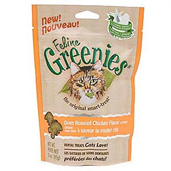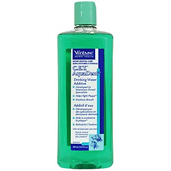By the age of three, 85% of pets have
problems with their teeth or the tissues that surround them.
Therefore, if you have an adult cat the chances are very good that it
suffers from dental disease that will only worsen over time without
appropriate care and pet meds.
"Cat owners can do a lot to slow the development of dental disease in their pets."
What Is Cat Dental Disease?
Dental disease is a catch-all term,
referring to any condition that adversely affects teeth or their supporting
structures. Common forms of dental disease include:
- Plaque – an accumulation of saliva, bits of food and bacteria that adheres to the surfaces of teeth
- Tartar – a hard substance that forms on teeth when plaque mineralizes
- Gingivitis – inflammation and possibly infection of the gums
- Periodontal Disease – abnormal pockets that form between teeth and gums
- Periapical Abscess – an infection at the tip of a tooth root
- Loose or Missing Teeth
- Broken Teeth
- Tooth Resorption
How Does Dental Disease Develop?
Every day, plaque is deposited on a
cat's teeth. With time, minerals present in saliva convert the
soft plaque into hard tartar. Plaque and tartar are very irritating
to the gums, causing inflammation which is known as gingivitis.

As tartar builds up and gingivitis worsens, the gums start to separate
from the underlying teeth. Within the pockets that form more plaque
and tartar accumulate, and a vicious cycle has started. Infection
and inflammation break down the connections between the cat's teeth
and jaw. Loose teeth that may eventually fall out are the result.
If a tooth is broken and the inner chamber called the pulp cavity is
exposed, bacteria in the mouth can travel through the tooth and into
the bone that surrounds the root producing a periapical abscess.
Cats are especially prone to tooth
resorption, a disease that goes by many other names including neck lesions,
cervical line lesions, cavities, and feline odontoclastic resorption
lesions (FORLS). The cause of this condition is unknown, but for
whatever reason painful holes develop in one or more of a cat's teeth.
Eventually, affected teeth may become nothing more than bumps under
the gums.
The Effects of Dental Disease in Cats
Dental disease is painful. Affected
cats may be reluctant to eat. Some may resent being touched around
the head, rub their mouths or chatter their teeth. Other typical
symptoms include:
- Bad breath
- Drooling
- Receding gums
- Red gums that bleed easily
- Pus draining from around
teeth or from swollen areas on the face
- Sneezing and discharge from
the nose
- Weight loss
- Irritability
Dental disease may also lead to health
problems elsewhere in the body. Bacteria can travel from the mouth
through the bloodstream and infect the kidneys, liver, heart and other
organs with potentially life-threatening consequences.
Veterinary Dental Care
A veterinarian will be able to examine
the mouth of a cooperative pet and get a general idea of the state of
its oral health. However, anesthesia is required for a full exam
and any treatment that will follow. Dental x-rays are often needed
to assess the health of tooth roots and surrounding structures.
Plaque and tartar is removed from all
surfaces of the teeth, including under the gum line, by scraping it
away with a hand or ultrasonic scaler. The teeth are then polished
so that plaque has a harder time sticking in the future. Fluoride
and other preventative treatments may also be included as part of a
dental prophylaxis. Severely damaged teeth, including those undergoing
resorption, should be removed. In some cases, root canals and
other types of oral surgery may be an option for saving a tooth.
Home Dental Care

Cat owners can do a lot to slow the
development of dental disease in their pets. Daily tooth brushing
is best. Soft bristle brushes, fingerbrushes, and even a washcloth can all be effective.
Use a toothpaste or gel designed especially for cats. Cats don't
appreciate the minty taste of human products, and the fluoride can cause
illness when swallowed. If brushing isn't possible, try Petrodex Dental Spray or any other cat dental wipe, mouthwash, or drinking water additive.
Some types of food have been specifically
designed to help remove plaque from a cat's teeth. Studies show
that regular dry foods are not as effective as are those that carry
the Veterinary Oral Health Council (VOHC)
seal. The daily use of treats and chews like Feline Greenies that contain mild abrasives, antiseptics or
enzymes that break down plaque can also significantly improve a cat's
oral health.
Even with the best of home care, most
cats still require professional dental cleanings from time to time.
See your veterinarian regularly so that any dental problems that do
develop can be dealt with swiftly before complications arise.
The above is provided for information purposes only and should not be used for the diagnosis or treatment of any condition.
This information does not cover all possible variables, conditions, reactions, or risks relating to any topic, medication, or product and should not
be considered complete. Certain products or medications may have risks and you should always consult your local veterinarian concerning the treatment of
your pet. Any trademarks are the property of their respective owners.